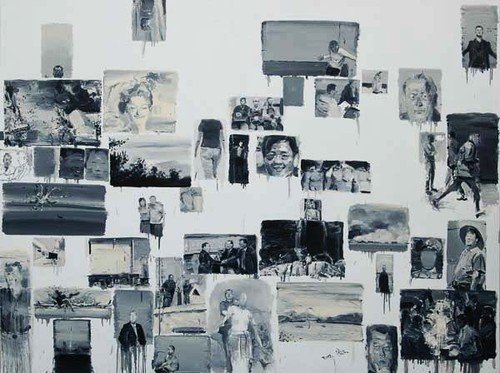Two exhibitions
dal 15/12/2007 al 30/1/2008
Segnalato da
15/12/2007
Two exhibitions
Platform China, Beijing
In the serie of works 'The Concealed Structure', Zhang Yuan using unknown images from extensive sources, constructs in a sensitive and delicate style an open space for interpretation, while giving the impression of an oncoming dense fog. 'Doors- One step further to the edge': Markus Willeke works with numerous cinematic references and in close relation to the cinema's omnipresence.

The concealed Structure -- Zhang Yuan Solo exhibition
In the serie of works – The Concealed Structure, Zhang Yuan using unknown images from extensive sources, constructs in a sensitive and delicate style an open space for interpretation, while giving the impression of an oncoming dense fog. As the images are separated from their own meaning and stories, they represent through complicated compounding and unfolded details, a sort of inane state and indefinable conjuncture, foretelling that a new situation is going to occur.
“……the important part is not the paintings and the images themselves, but the subtle emotions and the concealed structure created by the adequacy of the images and details ……, the images adjacent or not come to a montage-narration…” (the artist’s statement). Then the concept and the structure lie on the audience’s interpretations.
---------------------
Doors- One step further to the edge - Markus Willeke first Solo exhibition in China
Markus Willeke works with numerous cinematic references and in close relation to the cinema’s omnipresence. Willeke watches a large number of films and sees them many times in a row. Sometimes, only after all these repeated viewings, he will suddenly be struck by a detail he hadn’t previously noticed. Watching films in this way changes the consumption of a product of the culture industry into an aesthetic and open-ended project.
Markus Willeke is particularly taken by the horror genre. In scenes involving crime and violence, a crucial function in the structuring of the plot is assumed by doors, fences, demarcation tape, warning and emergency signs; they distinguish zones of danger from zones of safety, tell ‘here’ apart from ‘there’, the outside from the inside. Willeke isolates and processes his motifs in a complex procedure of transfer and selection. First of all, he photographs film stills from the screen, then paints small- or medium-format watercolours of chosen details. These motifs are then tested in a certain way for their compositional value so they retain their specific expressiveness once blown up onto monumental canvas formats. Strictly speaking, however, the results are not monumental: they are in fact reverted back to the real dimensions of the props or to their slightly exaggerated original proportions. The painted doors are a little larger than real-life doors, the painted fence just marginally higher than such barriers would be in the real world. Their colours are heightened, the doorknob, the knotholes in the wooden fence and similar details are rendered in almost caricatural simplicity.
Although watercolour is commonly associated with subtlety and with small, delicate formats, often mesmerizing the viewer’s gaze with gradual shifts of tonality, here the technique of its application is graphically bold and simple. Yet Markus Willeke has found a way of investing watercolour painting with a new task, up-to-date relevance and astounding power. His painting process is astounding too. First he floods the horizontal surface with very diluted paint using variously broad brushes, painting into the still wet paint, and deliberately working with the characteristic watercolour effect of letting one colour bleed or seep into the next. Since this needs to be done at speed, the picture’s composition has to be worked out in advance; drips and splashes cannot be avoided and are part of the overall dramatically illusionist effect.
It of course depends on the extent of each viewer’s knowledge whether the cinematic allusions in Willeke’s pictures can be spotted. In the aforementioned examples of doors, fences, hazard tape, warning and emergency signs, the painted surface has the same proportions and size as the form of the depicted motif, a classical case of trompe l’oeil. The way the paintings are hung only reinforces the sense of trompe l’oeil, taking account of the effects of the installation and the scenario staged within the real space occupied by the viewer: the door and fence paintings almost reach down to the floor, those showing demarcation tape criss-cross over each other.
By choosing first to acknowledge cinema’s omnipresence as a reservoir of prototypical imagery Willeke’s own painted images achieve a new intensity of expression and a new ‘illusionistic’ autonomy.
Image: Zhang Yuan Concealed StructureNo.2 210x280-2007
Platform China
No. 319-1 East End Art (A) CaoChangDi Village, Chaoyang District - Beijing



